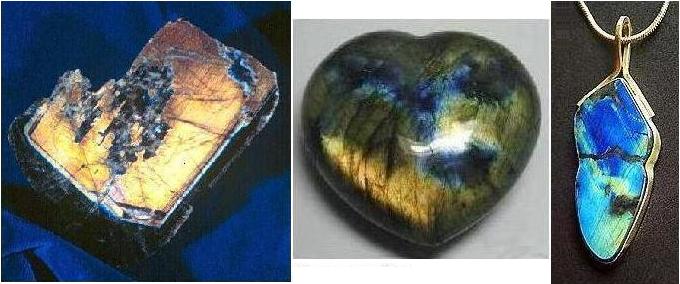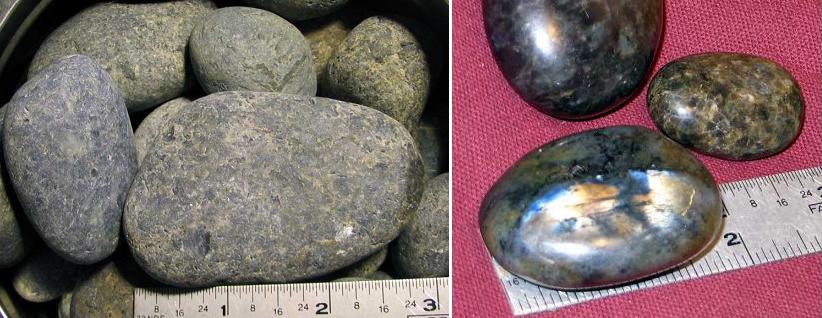ANORTHOSITE
( Fr- anorthosite; Ger- Anothosit;
Nor- anorthositt; Rus-  )
)
ANORTHOSITE

A. Labradorite grain (size not recorded)
from anorthosite mass near Nain, Labrador. (© photo by Jamie
Meyer, permission of Geological Survey of Newfoundland and
Labrador, www.geosur.gov.nf.ca)
B. Anorthosite (from Madagascar) heart
(width ~ 7 cm). Unconventional lapidarist. (© photo by
James Carpenter, www.unconventionallapidarist.com)
C. Labradorite ("Finnish Spectrolite")
pendant (height ~ 5.5 cm). Bernardine Fine Art Jewelry. (© photo
by
Nancy Bernardine, www.bernardine.com)
DESCRIPTION: Anorthosite is an igneous
rock
that consists of 90 or more percent of plagioclase feldspar, which is
labradorite in a large percentage of the anorthosites used as
gemrocks (see additional statements about this rock and its name and
about labradorite under
the
REMARKS subheading). Labradorite
properties follow:
Colors - overall medium to dark gray,
commonly exhibiting a
bluish sheen or even a play of colors consisting of patches
with bluish, greenish, purplish, golden yellow and reddish-bronzy
hues; rarely white or off-white
H. 5½ - 6½
S.G. 2.62-2.82
Light transmission - translucent to
subtranslucent
Luster - pearly to subvitreous
Breakage - two good cleavages,
irregular in other directions (which, of course, may lead to problems
for lapidaries!)
Miscellany - polysynthetic twinning, which
is
expressed by numerous parallel lines, is usually discernible on some
surfaces.
OTHER NAMES: Anorthosite is a widely
accepted petrographic designation. Several large anorthosite masses
around the world have been named on the basis of their locations and
are shown on geologic maps and referred to in geologic reports by those
binomial names -- e.g., the Marcy Anorthosite of the Adirondack
Mountain region of northern New
York and the Roseland Anorthosite of Nelson County, Virginia.
- Black moonstone - name
sometimes given dark labradorite (anorthosite) that exhibits only
sporadic bluish labradorescence.
- Bull's eye - name sometimes applied to
relatively dark labradorite (anorthosite); this
designation should be abandoned -- it has been given to several
minerals and rocks other than labradorite (anorthosite).
- Finnish labradorite - common name for
spectrolite (q.v.)
- Labrador moonstone - synonym of black
moonstone.
- Labradorite - some large grains of
labradorite, the chief constituent of most gemrock anorthosites, have
been
polished and
marketed as simply labradorite or "labradorite gemstone." Some of the
fashioned pieces contain one or more of the other macroscopically
discernable
mineral constituents of anorthosite and are properly termed gemrocks;
others are virtually 100 percent labradorite and are more properly
designated gem-minerals.
- Labradorite Bianca - a marketplacel name
of Madagascar anorthosite.
- Labradorite
Blue Australe - another
marketplacel name of Madagascar anorthosite.
- Lynx eye - labradorite/anorthosite with a
predominantly
green iridescence.
- Opaline feldspar - name sometimes given
labradorite from anorthosites; this misleading name should
be abandoned.
- Ox-eye - name sometimes applied to labradorite
(from anorthosites) that exhibits dark reddish hues.
- Plagioclasite (also plagioclase rock) -
term(s) sometimes used as synonym(s) for anorthosite; although
these terms pertain descriptively, they are not included in any widely
accepted system of petrographic nomenclature.
- Spectrolite (also marketed under the names Spectroliitti, Arctic
Blue and Finlandia Blue) - name sometimes
applied to a
predominantly labradorite gemrock from Finland. Some of the
anorthosite from which this gemrock is recovered is porphyritic, and
some of the the relatively large phenocrysts find use for fashioing as,
for example, cabochons; these gemstones are, of course, gem
minerals rather than gemrocks.
USES: Cabochons and
freeforms -- especially for relatively large brooches and pendants, but
also for smaller pieces of jewelry such as earrings and
stickpins and even beads for necklaces and bracelets; most of the
smaller stones are fashioned, as
just noted for Spectrolite, from individual
labradorite grains. In addition, tumbled pieces have been used in
such things as necklaces
and bracelets, and larger
pieces of rough have been made into wands, spheres, eggs and hearts
(Figure B) and carved/sculpted.
OCCURRENCES: Anorthosite occurs as relatively large igneous
masses or parts of such masses, especially those that are
called layered or stratiform masses. The coarser grained phases of some
anorthosite masses are sometimes alluded to as pegmatitic, and many
relatively large chatoyant grains of labradorite have been
recovered from these phases.

D. Anorthosite. Left. cobbles
from beaches on south shore of Lake Erie, near Saybrook (Ashtabula
County), Ohio; Right. polished pebbles
and cobbles from the same locality. (© photos by
Isaac Coblentz)
NOTEWORTHY LOCALITIES +: Tabor Island,
Nain
area of Labrador, Newfoundland Province, Canada; the county of
Ylämaa, southeastern Finland ("Spectrolite");
southwestern Madagascar. The + locality (Lake Erie beaches in
northeastern Ohio) is not really comparable to the other localities for
two reasons: 1. It is not a bedrock source; 2. The stones
thus far found are not of the high quality usually associated with the
anorthosite from the three just noted localities. The anorthosite
beach stones do, however, serve to emphasize the facts that rocks that
are well worth fashioning into gemstones etc. are not necessarily attractive
in the rough and they may be found where many people
might not look for them. As noted in the caption of Figure D,
this anorthosite was found on the south shore of Lake Erie, many
kilometers/miles from any recorded bedrock occurrences of
anorthosite. It seems likely that the cobbles and pebbles
represent pieces of rock that were glacially transported from one or
more of the anorthosite massifs
of the Grenville Province north and northwest
of Montreal, Québec, Canada. When they became
rounded stones is not known; it could have been prior to or after
they were glacially transported into the Lake Erie region. In any
case, Isaac Coblentz (personal
communication, January, 2006) notes that the beach
pebbles are commonly gray-black when wet, "chalky gray blue" when dry,
and exhibit small flashes of labradorescence ("flashes of dark blue,
green, light blue, gold, and very rarely red/orange and peach/orange")
that is "randomly distributed through the matrix."
REMARKS: Anorthosite is the accepted name
for phaneritic igneous rocks that consist of 90 per cent or
more calcic plagioclase feldspar (i.e., labradorite, bytownite or
anorthite), 0 - 5 percent
quartz and less than 10 percent mafic minerals (e.g., some pyroxene(s)). The name
anorthosite comes from anorthose, an
old -- now obsolete -- name for triclinic feldspars (which includes all
plagioclase feldspars).
Labradorite, as already noted, is the typical plagioclase of most
anorthosite
used as a gemrock. Named after Labrador (now part of Newfoundland
and Quebec provinces, Canada), this plagioclase is recorded as
having been discovered in 1770 by a Moravian missionary on the Isle of
Paul,
Labrador. This island is in the Labrador Sea, which is part of
the north Atlantic, just east of Nain on mainland
Labrador. The quality that makes labradorite
anorthosite so attractive, thus accounting for its use as as a gemrock,
is an
optical phenomenon whereby one sees color changes that involve one
or more
colors -- commonly blues, greens and/or
bronzy reddish hues -- when the
mineral is moved beneath
a source of light. This appearance, named for the mineral, is widely
referred to as
labradorescence. The cover photograph of a labradorite megacryst
on the 1998 Journal of Petrology
is well worth viewing: The pictured megacryst (~ 3 cm across),
which is
from southeastern Wyoming, exhibits spectacular zoning as well as fine
labradorescence.
An atypical anorthosite, also used as a
gemrock,
comes from a locality recorded only as the Philippines (Johnson and
Koivula,
1996). This rock is described as granular, overall white, and
containing
sporadic green crystals up to 2.0 mm across with its granular material
consisting largely of nearly pure anorthite plus minor interstitial
oligoclase
and crystals of zoned garnet, "primarily uvarovite with varying amounts
of andradite in solution." It is said to roughly resemble
jade.
Labradorite is the provincial mineral for
Newfoundland and formerly for all of Labrador. Spectrolite is the national stone of Finland (it "is said to be that colours reflect the nature of Finland:
blue is born the glittering of thousands lakes, green is the wuthering
of our country wilderness forest. Yellow, red and oranges are as
glowing brilliant colors of fall foliage in autumn."(www.finnishspectrolite.com) Also, in a letter I received from the
Governor’s
office
(dated June 13, 1977), anorthosite was listed as the New York State
rock; however, I have found no documentation of pertinent
enabling legislation for this status.
SIMULANT:
Larvikite -- see LARVIKITE entry.
REFERENCES: No general
reference.
| Top | Home |
R. V. Dietrich © 2015
Last
update: 3 October 2007
web page created by Emmett Mason
![]() )
) 